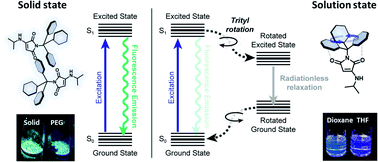Rigidochromism by imide functionalisation of an aminomaleimide fluorophore†
Abstract
Fluorescent dyes that exhibit high solid state quantum yields and sensitivity to the mechanical properties of their local environment are useful for a wide variety of applications, but are limited in chemical diversity. We report a trityl-functionalised maleimide that displays rigidochromic behaviour, becoming highly fluorescent when immobilised in a solid matrix, while displaying negligible fluorescence in solution. Furthermore, the dye's quantum yield is shown to be sensitive to the nature of the surrounding matrix. Computational studies reveal that this behaviour arises from the precise tuning of inter- and intramolecular noncovalent interactions. This work expands the diversity of molecules exhibiting solid state environment sensitivity, and provides important fundamental insights into their design.



 Please wait while we load your content...
Please wait while we load your content...